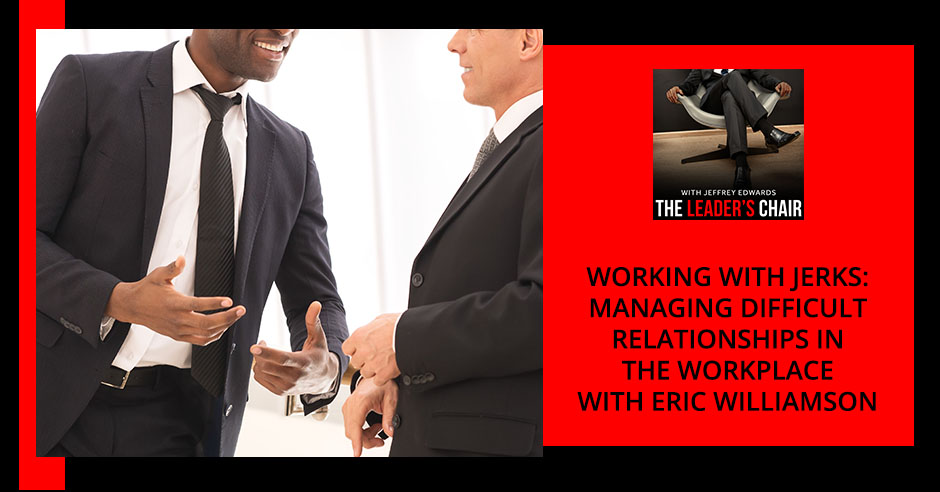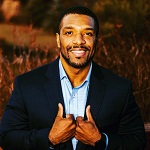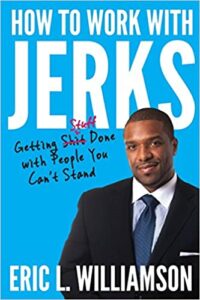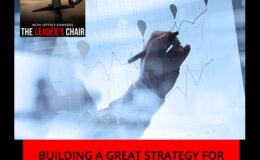
Nobody wants to work with a jerk. As a leader, you cannot achieve your singular vision without the help of your people, jerks included. You need to build relationships with everyone in the workplace. Some of them may be jerks and difficult but having the ability to get people to work together will do wonders. Navigate what factors to a jerkish environment with your host, Jeffrey Edwards, and his guest Eric Williamson. Eric is a conflict-resolution consultant who fixes conflict relationships in the workplace. He is also the author of How to Work with Jerks. Learn how to work with difficult people so that everyone can all work together to achieve success.
—
Listen to the podcast here:
Working With Jerks: Managing Difficult Relationships In The Workplace With Eric Williamson
I was talking to this gentleman. He’s going to be our guest. I came across his book that caught my attention. It’s How to Work with Jerks: Getting Stuff Done with People You Can’t Stand. You can understand that being talking about leadership, about building people, teams and strong organizations. I’m sure you wonder, “What are you bringing on here, Jeffrey?” Our guest here, he talks about working with difficult people. We’ll put that in that context.
He identifies a problem but what he does is bring solutions to those situations that allow organizations and the people within those organizations to work better and more cohesively, be more productive and produce great results. Bring it to our leader’s chair and sitting in our leader’s chair is our guest, Eric Williamson. He is a professional development consultant, author and a keynote speaker. He is here to share his wisdom, insights and career which is quite interesting and what his path has been. I’d like to welcome to our show, Mr. Eric Williamson. How are you doing?
I’m wonderful. I’m so happy to be here. Thank you for inviting me on your show. This is going to be a great time. I always love talking about the topic of when it comes to how to work with jerks. This is going to be a great time. It’s great to be here.
It’s something that when someone hears a title like your book, they have to ask the question, “Who is this guy? Is this guy talking to me? Is he talking about me? Is he talking to me? I’m not sure which one he’s referring to.” What was the inspiration behind that title for the book and what was the real emphasis that you want to put in writing a book like this?
I tell people that I am an expert jerk turn jerk expert. What that means is that I was a jerk. If you look at the word jerk in a dictionary, you would have found a picture of me. I was someone who was fresh off of graduated from college and I graduated with honors from a very reputable school. I thought I had it all together.
It wasn’t until I finally got into that very first job I applied to where I was brimming with confidence and you couldn’t tell me anything. When my mentor was assigned to me, was trying to tell me how to do my job and everything, I took it as my mentor was trying to show me how to do my job. I was saying, “I can do this on my own. If I graduated with honors in school, that’s going to translate to the real world. I can do this. I have the potential,” but I was surely wrong.
Not only did I mess up that relationship with my mentor but everyone else in the workplace that was around. A step further, once I realized that I was a jerk, I started listening to so many other people tell me about how difficult it is to work with their boss or their colleagues and how much of a jerk it is they are. I realized one thing that a lot of them had in common, which is this.
It doesn’t matter how smart and talented and gifted you are. If you are extremely talented, the one thing that’s going to make you ineffective or make you just want to quit or leave that situation is the inability to work with other people especially people who have different personalities, motives and agendas.
When we deal with people who are different from we are, that’s going to be the main thing that’s going to impede your own progress and the progress of the organization. Once I learned, I sat down and thought about my own jerk story, how I became a jerk and I listened to other people’s jerk stories. I listened to my wife and about her situations at work. I said, “What if I came up with a book that could help people address these situations with people that they can’t stand? It would promote more longevity, bridge the knowledge gap and help people become more successful in what they do and who they serve.” That’s what inspired me to put the book together.

Work With Jerks: It doesn’t matter how smart and talented you are. You are ineffective if you lack the ability to work with other people, especially people who are different from you.
It becomes something that I feel that you’ve taken from your personal experience. Now you’ve used that as a learning tool for others to learn from for themselves. It’s funny how much that in sharing what you’ve said how many people can relate to that. You’re coming out of school and out of a situation where you feel like you have all the answers. You feel like you know what’s going on. You worked with a mentor as well. What was it that brought you to work with the mentor to begin with?
First of all, I had no choice. That’s one of the things that when I first got into my job, the first thing my boss said is that, “I’ll help you get acclimated to your role. You need to be assigned a mentor.” It was fitting because I was the youngest person in the office. I’m a Millennial. I’m on the cusp of being a Millennial, Generation X, one of those 1980s timeframes. Everyone else had already graduated from college. They already had their career set. The person that was assigned to me, the mentor, was an up-and-coming person. She has been on the job for at least five years. She knew what was going on and she was going to be the person that was going to show me how to do my job.
For some reason, I thought that because I had so much success in college, that was going to automatically translate into career success and that was not the case. I was humbled. I’ve ruined many relationships quickly and it took a while for me to prepare those relationships. Talk about making that first impression, it was a terrible first impression.
There was a point where I faced 1 of 2 situations. I was about to quit or I was about to get fired. I had to do something about that quickly because getting your first job, I went from being on top of the world bragging about it like, “You’re about to lose this first job.” In a matter of months, whatever record that was, I probably would have broken it.
Thankfully, my boss who was about to fire me said, “I want you to attend an emotional intelligence course.” At first, I thought that he was trying to tell me that my emotions are stupid. I didn’t know what emotional intelligence was. I said, “Are you trying to tell me I need to have better emotions?” He said, “No. You need to be aware of how your behavior and emotions are affecting other people and you need to be aware of how it affects you.” I got defensive when people ask me about what was going on with my work. I would get sarcastic or rude towards people who were trying to help me out. I didn’t see it that way.
It wasn’t until I realized how I was behaving because of that emotional intelligence course where I was like, “I’m a jerk.” To be honest with you, I said something worse than that. Jerk was more appropriate at that time. The book How to Work with Jerks is about that but it’s inspired by emotional intelligence and that is the ability to manage your emotions and behaviors. That’s what drives this book to help other people manage their difficult situations as well.
From your biography, it recognized that you received national attention on major networks, NBC, ABC, Fox and CBS News. From your perspective on sharing leadership and the emotional intelligence relationship between the two, how is it that you’ve used your own personal experience as a professional service to other organizations?
Once I bought the book, people started reaching out to me. Understand that how to work with jerks is a polarizing topic. Either people love the topic or they say, “What are you trying to say? What are you getting at?” At the end of the day, it’s for sure a conversation starter but as I published this book, people would come up to me with their jerk problems say, “I’m having difficulty doing this. I can’t get along with this person. This is affecting my career.” I would give people advice about how to navigate through those tense situations.
Success in college doesn't automatically translate into career success. Click To TweetMy wife was saying to me, “You can add more service to people. You can help people out. Why don’t you offer your services to people around the book and help them with their specific situation?” I listened to her. You got to listen to your significant others. She was smart about that and she was onto something. Once I started officially telling people, “I can help you out with your situation,” it resonated with people because whether or not you want to call someone a jerk or not, at the end of the day, the difficulty is about how to build relationships with people that you work with and serve.
Whether you’re in customer service or behind the scenes working with your colleagues, the one thing that impedes progress is the inability to manage relationships. If you can’t do that, you’re going to be ineffective at what you do. I wanted to come out to provide a service to people to help them bridge those relationships. That way they can be more effective with the people that they work with and serve.
What’s been your experience from taking that tack? You’ve gone out there, you’re working with organizations. What has been your experience when you walk in, you’re being called into an organization to help them out? How would you start those conversations? Especially, if someone would say, “I read your book How to Work with Jerks.” First of all, I would be a little self-conscious to reunite in the lunchroom cafeteria with everyone else. We’re looking at, “Why is this person reading this book, I work with them?” How would that conversation go?
Someone had reached out to me on social media and they said, “I bought a copy of your book. I’m a VP and I’m in a leadership position. I’ve read your book because I’m having difficulty working along with my leadership colleagues.” They said jerks but you can infer it with something a little bit more than that. “Can you please tell me a little bit more about what you do and how you can help people like me?” Usually, that turns into a discussion, me learning a little bit more about the situation, their unique needs and how this affects not just them but the company overall.
A lot of times the VPs of organizations, the leadership, the CEOs either want to reach out with 1 of 2 things. Either they want to manage relationships with their colleagues or the people that they work with or they’re trying to change the culture. People who have reached out to me because they are in the process of mergers and acquisitions. That comes with a lot of conflict and changes.
In order to manage those changes, people look to the book as the gateway to manage not just relationships but conflict. Culture changes change management situations. They look to me to help manage the conflict or the anticipated conflict to not only deescalate it but to prevent it from occurring or getting out of control.
A lot of times, you know yourself. When you’re in a leadership position, you’re focused on strategic planning and succession management. You’re creating a vision for your organization. If you have to get down in the weeds of managing conflict between your colleagues and your staff, that’s taking away time and effort from you to see that big picture.
A lot of times, they’re looking for that big picture of focus and how they can get back to focusing on that. They say, “Help me deal with this situation here because I don’t have the time, effort, specialty or expertise to deal with it. After that conversation, we have some more conversations and then I put together a program that addresses their unique needs. That’s what it looks like.
When people additionally say, “How to work with jerks?” They may not agree with that. They may like that dealing with difficult people side of things. In the way, once we talk about how that book can help people, not only manage relationships but conflict. I say, “I get it now. I’d like your help because I’m dealing with this specific situation and I know you can help me out.”

Work With Jerks: When you’re in a leadership position, you’re focused on creating a vision for your organization. If you have to be the one to manage conflict between your colleagues, that’s taking away time from your vision.
From a senior leadership perspective, remember that senior VP or C-suite always talk about strategy. You have to have a vision and that big audacious goal. We always talk about all these great seminars. I always come back to the question that you’re asking and others might ask as well. You can have a big strategy and you also need the people to implement it.
If you don’t have a good relationship with the people that are either working as your peers or working or reporting to you, how do you expect to achieve this vision in fullness? I find it’s amazing how that gets overlooked or it gets minimized, “We’ll get it done somehow.” It seems to be pretty important to have both of those elements in place in order for success to happen.
I was taking a step further. It’s not only important. It is essential and necessary. You can’t have one without the other. That’s why in the book, there’s a chapter where I talk about what contributes to a jerk environment and identify poor circumstances. One of those circumstances is the lack of training and preparation. Even in middle management but particularly in senior leadership, even though you may be a couple of layers removed from the people, that still can’t stop you from ensuring that the people who are doing the work for you are still in a good place. Also, you are making a concerted effort to invest in them and to include them in your strategy.
That strategic planning, they’re not just chess pieces. Sometimes you get this picture of a leader saying, “Let me move this person here. Let me do this. This is the vision that I want.” When you fail to include your team, the people that are doing the work and you fail to account for that, now you’re getting yourself in trouble because they may not align with that strategy. They may have something else going on. They may not be happy with what you’re doing. As a result, that can blow up your strategy because you overlooked the most essential part of that situation, which is the people. It’s the people that drive the strategy and make the results. You’re the one that’s supposed to be executing that strategy. You can’t do it without them though.
What do you say when it comes to virtual teams and working with remote teams? As society continues to unroll and there’s more technology in place, more people are working remotely either in coworking spaces or even from home. It would also seem to be more challenging for older generation workers. Unlike Millennial managers and professionals, there’s still that mindset of the traditional workplace where everyone’s coming in, goes to the front door and sitting in the same spot. We’ve seen over the past several years that that dynamic is changing.
When I published the book How to Work with Jerks, one of the other circumstances in the book that I identified that creates a jerk environment is technology. I talk about how not having that face-to-face connection can create a jerkish environment because you’re not able to necessarily observe people’s body language.
When you’re looking down at your phone, your equipment or you’re using your electronic devices, that’s one more thing that’s a barrier in your way of building that relationship. If you think about it, that’s all we’re relying on. Before there was probably a balance of maybe 50/50, 60/40 working virtually versus working at home and people have that option now.
At one point it was just 100%. Some people are going back to the office. Now it’s like, “Are these people jerks because they’re using their equipment?” No, that’s not the case. People have adapted to the situation to use the most effective use of technology to communicate and build relationships. You can still accomplish a lot of things in terms of building relationships with people over a Zoom call.
Sometimes, some situations require communicating via Zoom, picking up the phone or seeing an email. Depending on what you choose is going to have a direct impact on how you build that relationship. How many times have you heard someone interpret someone’s attitude by reading an email saying, “That’s a good idea?” Did you see what this person said? How sarcastic were they? We interpret so many different things, which is why we don’t understand the proper medium to have those conversations using this equipment that we have.
The one thing that impedes progress is the inability to manage relationships. Click To TweetThat can still contribute to that jerk place environment. You’ve got to find the right balance to it though. Not even just with COVID now because people are pushing back. They’re like, “I’m not going back to that office again. You can’t expect me to do that full-time.” There are a lot of pushbacks now. It’s then the employer’s best interest to accommodate that because now we are different people out of this COVID environment. It means we have to require another way of doing business, which is not the same old being in the office and having these meetings. We have to have that flexibility because if you don’t, that’s when you have more jerks, people leave and that’s why you had this tsunami turnover, people will leave to another place that’s more accommodating.
One of the central points that pulling out what you’re saying, is that the big part of it is knowing your people. Knowing what motivates them, what energizes them, what is going to be the most appropriate way of engaging with them so that you do build that trusting relationship, strong communication lines. There are people that I’m sure that you know that if you send them a text, they’ll respond right away. If you try and call them or email them, you might as well wait for it next month.
There are others that just prefer email. I know that from my own experience especially the younger the workers are. When we get into the categories of Millennials or Gen Y, it’s more the texting and video seems to be more appealing whereas be more my generation or older, email or phone calls are still welcomed.
By popular demand especially with the Millennial and the Generation Z folks, even the Gen Xers too, that might be like the preferred method. Text messages, the quick efficient types of communicating but I don’t want to lose sight of one important thing. Even with these younger generations that are coming into the workplace, they have more responsibility now. It’s more responsibility than other older generations. Here’s why because now, the younger generations have to be more proactive.
We have to bring situations to the table, to our leadership. For example, if my leader is looking for a status on a project or something, I can’t wait for her to say, “What’s going on with this?” I have to be the one to say, “This project that I’m working on, here’s what’s going on.” I have to bring it to the table because that leader is way more involved in all these other things remotely. We don’t have the luxury anymore of doing those flybys to check in on people like me or anyone else about how they’re doing because there are so many other things that are going on.
This is the new way of navigating through this virtual environment. These younger generations have to be more proactive, anticipate when there’s a problem or when there’s an issue and we have to make sure that we’re being proactive about it and presenting those issues in a timely manner. We can’t wait. We have to do it immediately.
Doesn’t that fall into what you referred to on this chat in regards to the training side to it? It’s important when you’re saying that relationship, first of all, it’s that common understanding. What’s expected of me and what I can expect of you so that there is a clear understanding of roles and responsibilities at the outset? When you’re bringing someone into your team or you’re being hired to come into a team so there are no misunderstandings along the way.
The lack of training and preparation, for me working with different organizations, I’ve discovered that it’s often overlooked. I know for certain that it’s never undervalued. Once people recognize the value of it, they say, “Here’s where I’m getting the most out of it. Here’s the outcome for me. I’m going to have a much more effective staff.” Let me drill that a little bit more on this. In the leadership part, they need the training because oftentimes leaders are promoted to a level beyond their capability. They were effective at doing the technical job very well but now they lack the skills that are needed to lead people because now in the leadership position, they’re no longer doing the work.
It requires a whole other skillset. Sadly, these people don’t often get that training, which is one of the reasons why I’m brought in. On the other side with the staff who are being onboarded, it’s more than just a week of orientation. It’s got to be an ongoing concerted effort to make sure that the staff understands what these expectations are. You can’t wait for a mid-year review and the performance review. It’s got to be early and often via one-on-one meetings, weekly meetings, things like that to reinforce those expectations.
It’s always going to come back to creating the culture and that environment where people come in, they know what is expected aned what the outcomes are. “This is how we do it. This is who we are. This is how we do. Here’s how you get subscribed to this process.” Isn’t that the way it should work or you “shouldn’t?”
First of all, I agree with the air quotes because at the end of the day, it does come back to culture but here’s the deal, culture doesn’t mean anything unless people feel safe. What I mean by that is if your leadership doesn’t feel safe about setting these expectations, if the staff doesn’t feel safe to express their concerns or their ideas, culture doesn’t mean anything.
That means it’s just lip service. When you run into people or leaders that say, “I want to promote a culture of engagement, respect and all this and that.” If your organization does not feel safe to have these discussions for fear of being ridiculed, reprimanded, ostracized, ignored, all those things then what good is the culture? The culture is only as good as the people who feel safe in that environment to contribute to that culture because you need everyone.
Where would that start? There is a point in an organization where the buck stops somewhere. In your experience, where would you begin?
First, I would begin with leadership. That would be the first thing because they’re going to set the stage. They’re the ones who are responsible for incorporating that culture. That leader has to understand the fundamentals of creating this culture where there’s respect, engaged leadership and people feel safe to innovate and contribute to the group.
The leadership has to set the stage first but once they do that, now you’ve got to empower the staff and the team to be able to understand that they can feel safe enough too and they can be empowered to make certain decisions. Also, to have certain control over how projects are being done, to how work is being implemented and completed. Once you have that top leadership set in the stage and these get buy-in and support from the staff, now you’ve got everyone involved. It’s not necessarily top-down. It begins with the top then it continues with the staff and it’s an ongoing cycle of give and take with both members.
When you refer to leadership, who is in that leadership group that you’re speaking to that sets the tone and the environment?
I’m talking about the CEO, the VP and the president of associations or companies because what they do, that’s going to empower that middle line level of leadership. The team leaders or the directors empower them to set the stage for the people that report to them. You can’t just focus on the people with titles. You’ve got to focus on the people without title and empower them to be able to lead without that title so that way it looks out for everyone’s best interests, which is within the organization. That’s how you get that culture cultivated from top-down, sideways, hierarchal, whatever.
It’s interesting to hear your perspectives on this topic. To find out from you, what have you learned about yourself now having written a book? You’re being engaged. You’ve been on national stage talking about this topic. You’ve worked with organizations on these issues. When you look back to your early experience as a professional to where you are now, what advice or mentorship would you provide to the earlier Eric that you were back then?
As a leader, you can't execute your business strategy without your people. They make the results. Click To TweetWhat would the new me say to the old me? The first thing I would say after reading my own book is, “Relationships matter now more than ever before. It’s inherent. It’s incumbent upon you to build relationships with people that you work with and serve. You don’t have to like everyone. The better you are at building relationships, the more successful you will be in the future. You may not realize that now but all that equity that you built up from building relationships, that’s going to have an impact down the road. The people that I was cordial with that we worked on things together, those people still matter. You’ll be able to go back to them and work with them more and learn from them as well. The people that you didn’t get along with, you’re going to learn just as much as the people that you did get along with. It’s always a learning lesson and take those relationships as learning advice.”
I’m sure that the old you would be open to the idea but they still may blow you up. It’s amazing how years of experience and having walking through those experiences provide that expanded sight to what’s possible. When you look at where you are now in your career, in your organization, what’s the next big step for you that you see in the work that you’re doing?
There are a couple of things I’m working on. First thing, I’m working on book number two and this is about how to promote a jerk-free environment. The first book was more about the one-on-ones or the one with the group and stuff about how to build relationships with those specific people. To what you were talking about before about the culture, this book is about how to promote the culture environment, where people feel safe that can contribute and how you can promote a drug-free environment.
The other thing I’m working on now is I am following through on that by working with various organizations and promoting a drug-free culture through managing conflict and preparing them for their next initiatives and change in management. Those are the things that I have on my plate immediately. I’m sure there’s going to be a lot more down the road but these are the two things that I’m most focused on.
It’s great. I’ve enjoyed our time here. I want to thank you so much for being part of this episode. If people were interested more in the book, How to Work with Jerks, where could they get that book?
The first thing you can do is go on Amazon. All you got to do is type in How to Work with Jerks. If you just type in the word jerks, I’m sure the cover of my book will show right up there. You can also contact me on my website at TailoredTrainingSolutions.com. If you’d like the signed copy, my contact information is on my website. I always have a reserve of books for anyone who would like a signed copy. I love mailing them out. Those are the two ways that you can get access to the book and to me as well.
It’s always great to connect with you. You just keep bringing it and keep shouting, keep saying your message out there. Jerks no more. That’s it.
It was a pleasure being on the show. This is an awesome thing. I love it. Thank you so much for your time too.
It’s my pleasure. Take care and we’ll touch base down the road.
I’m looking forward to it. Take care.
—
That brings us to the end of this episode. Special thanks to Eric for joining us here and sharing his experience. Thank you for allowing us to be a part of your day. If you’re new to this show, subscribe. You can go to Apple Podcasts, Spotify, Google Podcasts, wherever you listen to your podcast. Subscribe and give us a review of this episode. Give us a five rating and share it with your friends, people that you feel would benefit from the information, resources and the people that we share here to help you on your leadership journey. I look forward to touching base with you again. Until next time. Always remember, be good and lead well.
Important Links:
- How to Work with Jerks: Getting Stuff Done with People You Can’t Stand
- Eric Williamson
- Apple Podcasts – The Leader’s Chair
- Spotify – The Leader’s Chair
- Google Podcasts – The Leader’s Chair
About Eric Williamson
 Eric Williamson is a professional development consultant, keynote speaker and author of the book: How to Work with Jerks: Getting Stuff Done with People you Can’t Stand. He works with organizations to build successful leaders by building stronger customer and workplace relationships.
Eric Williamson is a professional development consultant, keynote speaker and author of the book: How to Work with Jerks: Getting Stuff Done with People you Can’t Stand. He works with organizations to build successful leaders by building stronger customer and workplace relationships.






